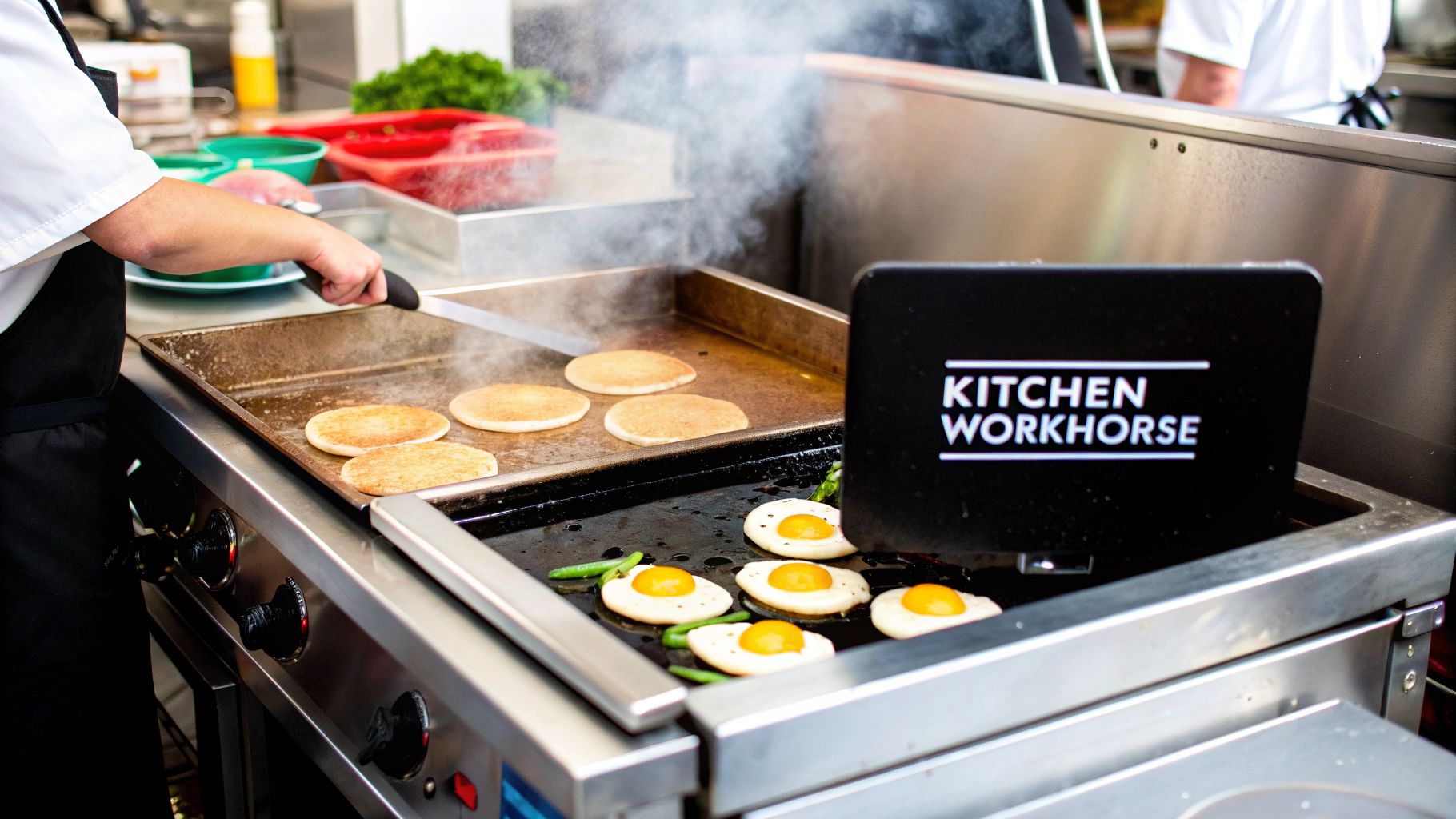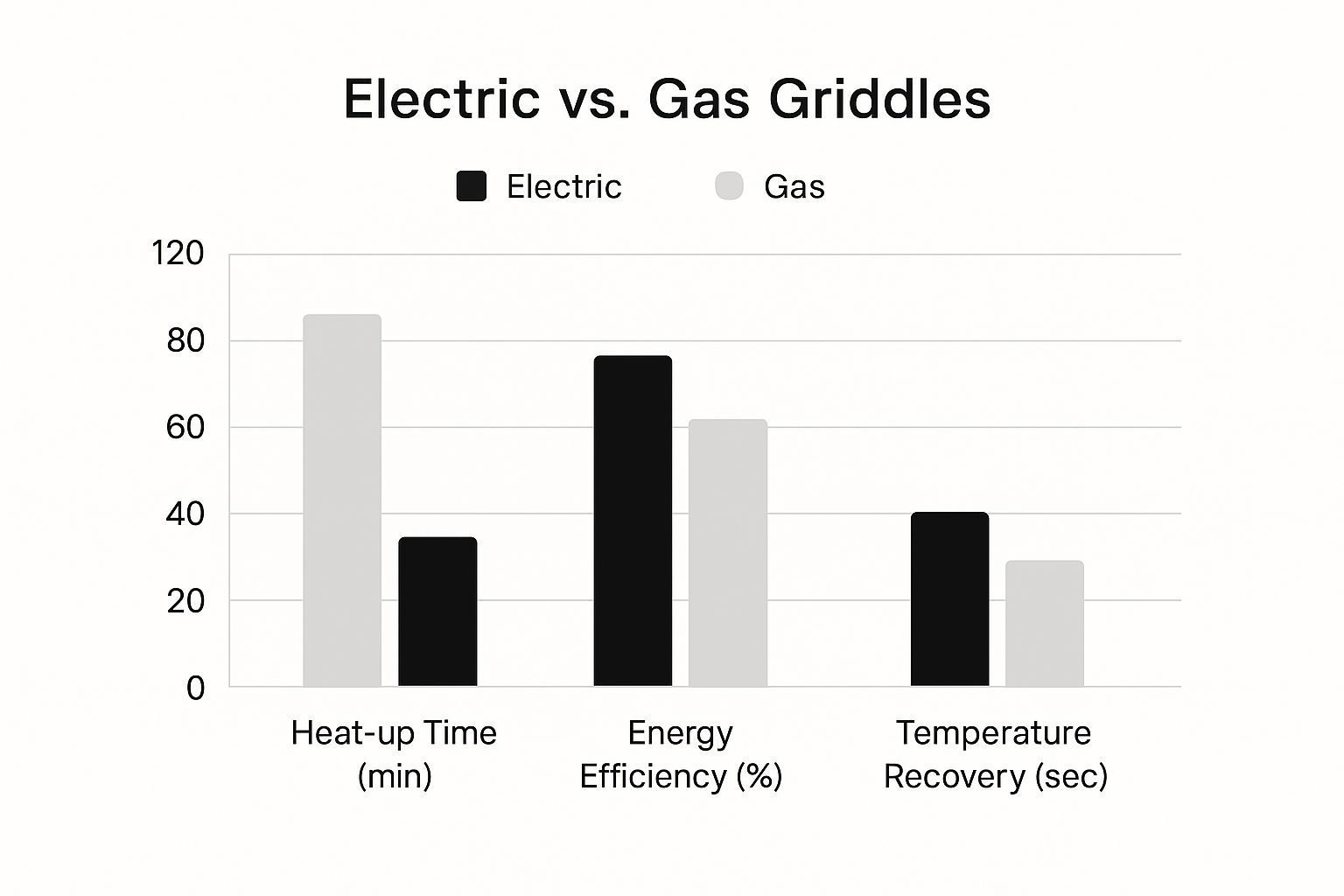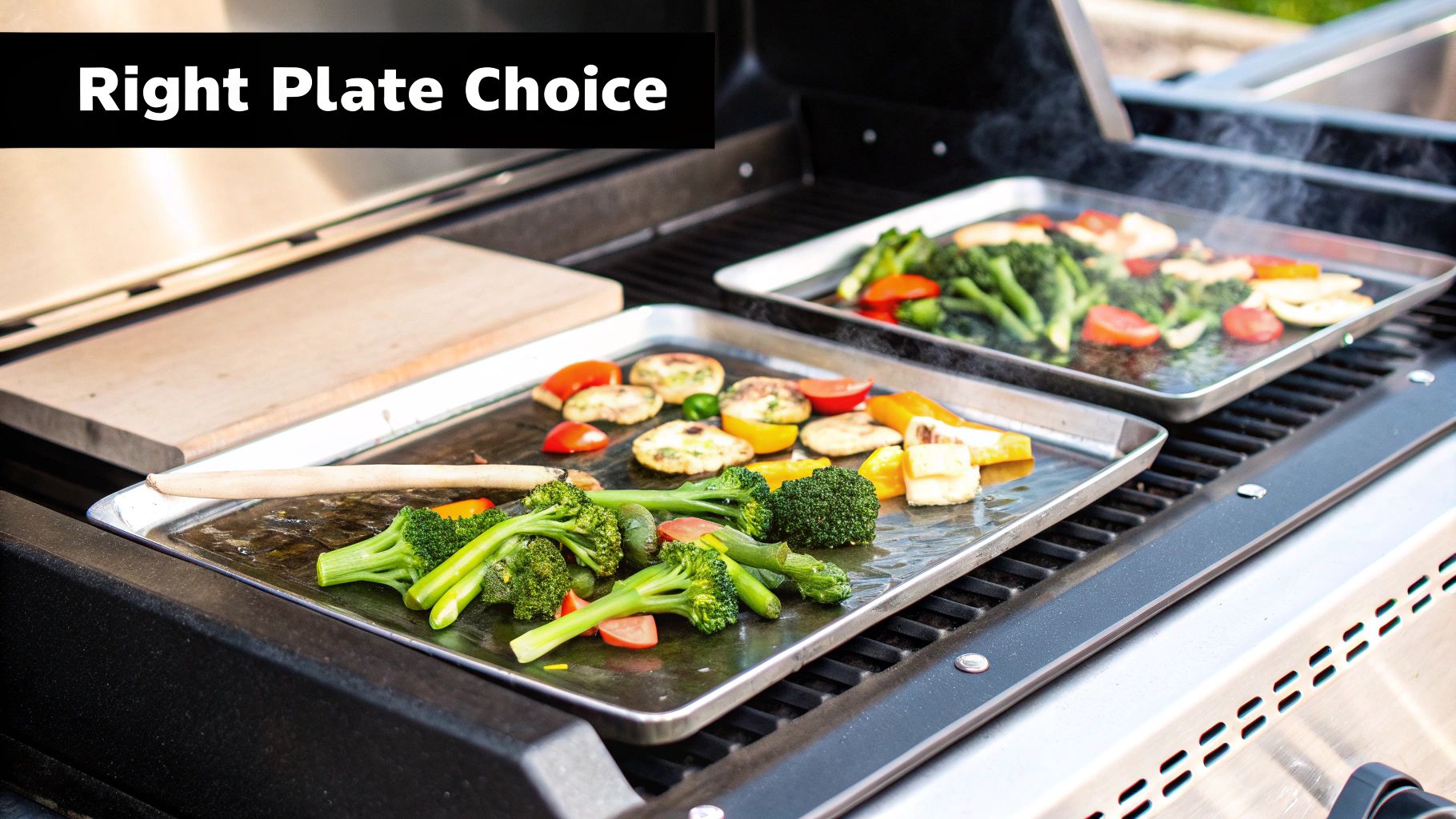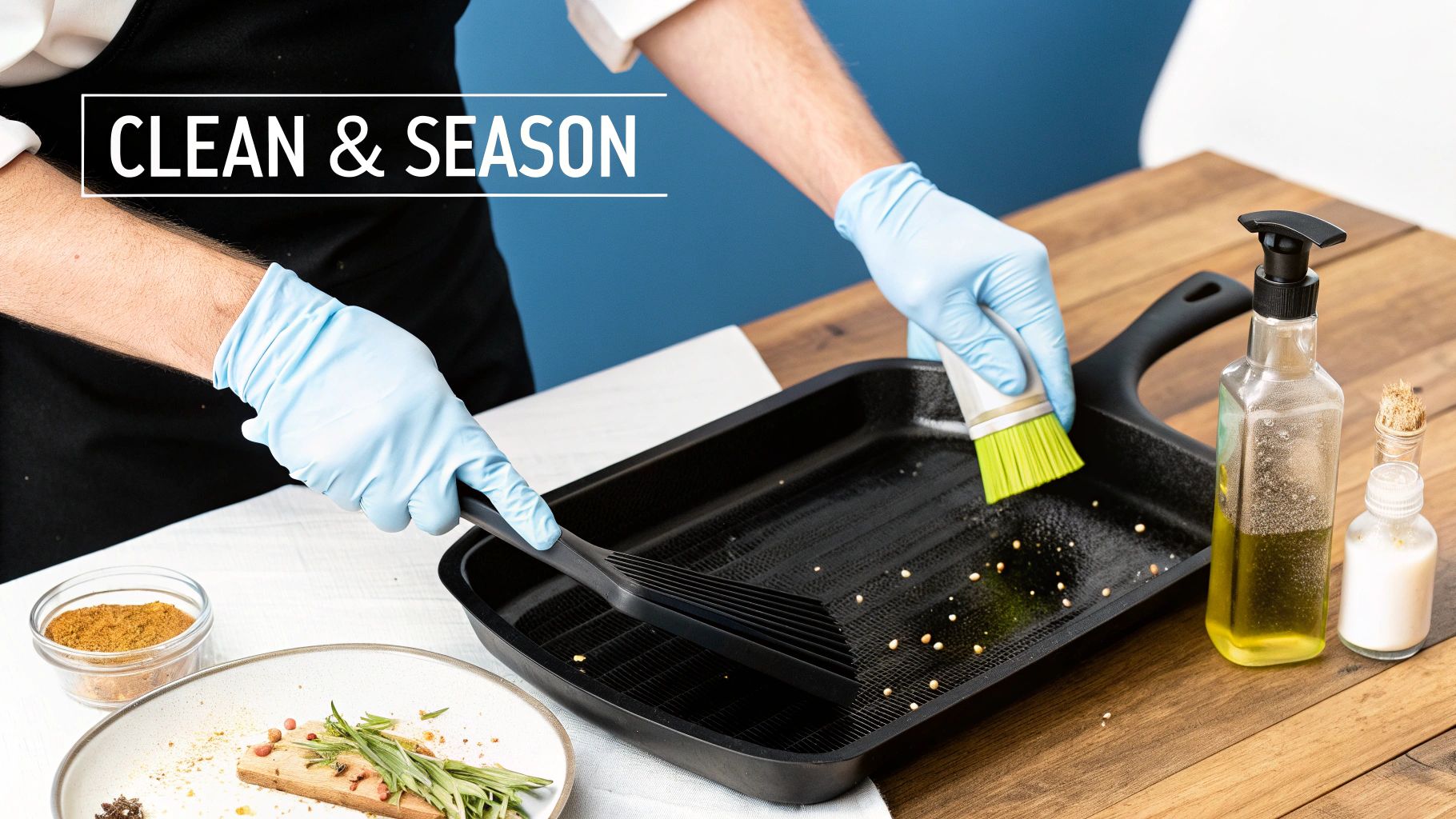
Your Guide to Commercial Griddles
If there's one piece of equipment that's the unsung hero in countless professional kitchens, it's the commercial griddle. This flat-top cooking surface is the key to delivering consistent, delicious food, whether you're flipping pancakes at dawn or searing steaks at dusk. It's a true multi-tasker that can seriously boost your kitchen's efficiency and menu potential.
Why a Commercial Griddle Is Your Kitchen's Workhorse

Think of a commercial griddle as the reliable, rock-solid core of your cook line. Unlike a standard stovetop where you're juggling individual burners and pans, a griddle gives you a massive, uninterrupted canvas. This single design feature is what makes it so powerful—it lets your chefs fire off multiple orders at once without breaking a sweat.
That versatility is what really sets it apart. In the morning, it's covered in sizzling bacon, perfect pancakes, and fluffy eggs. Come lunchtime, that same surface is searing off burger patties, toasting buns, and grilling up veggies. Being able to pivot between meal services without swapping out equipment is a total game-changer for kitchen workflow.
Boosting Kitchen Efficiency and Consistency
One of the biggest wins with a quality commercial griddle is its ability to churn out consistent results, order after order. The thick cooking plate is built to hold and distribute heat evenly, which gets rid of the frustrating hot and cold spots you find in thinner pans.
What does that mean in practice? Every pancake comes out golden brown, and every burger is cooked to the exact temperature your customers crave. It takes the guesswork out of cooking and lets your team work faster and with more confidence, even during the craziest rushes.
This reliability means higher output and, ultimately, better food.
Expanding Your Menu Possibilities
A griddle doesn't just make your current menu items better; it opens the door to a whole new world of culinary creativity. That direct, even heat is exactly what you need to achieve the Maillard reaction—the magic chemical process that gives seared foods their incredible flavor and beautiful brown crust.
This makes it the perfect tool for:
- Breakfast Classics: Flawlessly cooking eggs, pancakes, French toast, and all your breakfast meats.
- Lunch Favorites: Crafting killer smash burgers, Philly cheesesteaks, gooey grilled cheeses, and quesadillas.
- Dinner Entrees: Putting a perfect sear on steaks, chicken breasts, fish fillets, and a whole range of vegetables.
The market is split between countertop models and larger floor-standing units. Countertop griddles are becoming a go-to for smaller spots like cafes and food trucks because they save so much space. Unsurprisingly, quick-service restaurants (QSRs) are the biggest users, depending on griddles to handle their high-volume demand. You can dig into more data on commercial cooking equipment trends to see how the market is shifting.
Choosing Your Heat Source Electric vs Gas Griddles
Picking between an electric or a gas commercial griddle is one of the biggest calls you'll make for your kitchen. This single choice impacts everything from your cooking speed and utility bills to how much control you have over delicate dishes. It's not just about what hookup is available; it’s about aligning the griddle’s personality with your menu.
Both electric and gas models get the same job done, but they take completely different paths to get there. It’s a bit like choosing between an automatic and a manual car. Both get you down the road, but the feel and control are worlds apart.
The Case for Electric Griddles
Electric griddles are the undisputed champs of precision. They work by using heating elements mounted right under the griddle plate, all governed by a thermostat. This design gives you incredibly consistent and even heat across the entire surface, which means no more surprise hot spots that can ruin a dish.
That level of consistency makes electric griddles the go-to for sensitive items that need exact temperatures, like:
- Pancakes and Crepes: Nail that perfect, edge-to-edge golden-brown color every single time.
- Eggs: Cook delicate over-easy or sunny-side-up eggs without scorching the whites.
- Delicate Fish: Get a beautiful sear on a fish fillet without the risk of overcooking it.
They might take a few extra minutes to heat up, but their excellent heat retention and efficiency often mean lower operating costs in the long run.
The Power of Gas Griddles
When it comes to raw power and speed, gas griddles are in a league of their own. They're the workhorses of high-volume kitchens because they heat up fast and recover their temperature almost instantly—even when you drop a dozen frozen burger patties on them. That rapid response is a lifesaver during a chaotic lunch rush.
Chefs often prefer gas because it gives them a more direct, intuitive feel for the heat, letting them make quick adjustments on the fly. This makes gas griddles the top pick for kitchens cranking out burgers, steaks, and cheesesteaks at a rapid pace. If you already have a gas line, they are usually cheaper to install and operate, too. When you're looking at gas, it's also smart to know your fuel options. You can learn more about natural gas vs propane setups in our other guide.
Here's a straightforward look at how these two heat sources compare head-to-head.
Electric vs Gas Commercial Griddle Comparison
| Feature | Electric Griddle | Gas Griddle |
|---|---|---|
| Heat Distribution | Excellent: Provides even, consistent heat. | Good: Can have hot spots near the burners. |
| Temperature Control | Precise: Thermostatic controls offer exact temps. | Responsive: Allows for quick, manual adjustments. |
| Heat-Up Time | Slower: Takes longer to reach cooking temperature. | Fast: Heats up very quickly. |
| Recovery Time | Slower: Recovers heat more slowly after adding food. | Excellent: Recovers temperature almost instantly. |
| Best For | Delicate items like eggs, pancakes, and fish. | High-volume searing of burgers, steaks, and proteins. |
| Energy Efficiency | Higher: Better heat retention leads to lower costs. | Lower: Less efficient but often has lower fuel costs. |
| Installation | Simple: Plugs into a standard electrical outlet. | Complex: Requires a professional gas line connection. |
Ultimately, there's no single "best" choice—only what's best for your operation.
The infographic below breaks down some of the key performance differences you can expect.

As you can see, gas takes the lead in speed, but electric models pull ahead on efficiency. Think carefully about your menu and workflow to pick the griddle that will truly help your kitchen fire on all cylinders.
Matching Griddle Size and Plate Material to Your Menu

Once you've landed on a heat source, the next big decisions are the griddle's size and plate material. These two pieces of the puzzle directly control how much you can cook and how well you can cook it. Getting this right is the key to sailing through a busy service without breaking a sweat.
The size of your griddle—its width and depth—is all about cooking capacity. It's a classic mistake to underestimate how much surface area you'll need when the ticket machine starts screaming. A solid rule of thumb is to figure out your max output for your most popular griddled item and then choose a size that can handle that volume with room to spare.
This isn't just about fitting more burgers on the flat top; it's about your entire kitchen workflow. The global commercial cooking equipment market, now valued at over USD 11 billion, is growing right alongside the boom in quick-service restaurants that live and die by high-output gear like griddles. As more spots open up, the need for efficient equipment that pumps out volume is only getting bigger. You can discover more insights about commercial cooking equipment growth and see where the industry is headed.
Understanding Griddle Plate Materials
Think about choosing a griddle plate like picking the right pan at home. You wouldn't try to sear a steak in a thin, non-stick skillet, right? And you probably wouldn't attempt delicate crepes in a heavy cast-iron pan. The same logic applies here. Different materials bring different strengths to the table for heat retention, sticking, and cleanup.
You'll mainly run into three types of materials:
- Steel: This is the workhorse of the griddle world—the most common and versatile choice. Standard steel plates are typically ½ to 1 inch thick, giving them fantastic heat retention. They're perfect for smashing burgers and getting a hard sear on steaks. They do need to be seasoned to build up that non-stick surface, but they're built to last.
- Chrome: A chrome-plated griddle top is the undisputed king of non-stick cooking. That mirror finish actually transfers less radiant heat, which means it cooks food more gently and prevents sticking with very little oil. It's the go-to for delicate items like eggs, pancakes, and fish.
- Composite: These plates are a hybrid, often featuring an aluminum core for fast heating and a stainless steel top for durability. They strike a good balance between performance but are a bit less common than your standard steel or chrome models.
Matching the Plate to the Menu
The trick is to line up the material's best qualities with what's on your menu. If your diner is slammed for breakfast every morning, a chrome top is going to be your best friend. You'll be flipping endless eggs and pancakes without a single one sticking.
On the other hand, if your food truck is famous for its perfectly seared smash burgers, a thick steel plate is non-negotiable. Its ability to hold that blistering heat ensures you get that delicious, crispy crust every single time, even when the line is wrapped around the block. By carefully matching the material to your food, you set your kitchen up for consistent, high-quality results.
What To Look For in a Modern Commercial Griddle
A great commercial griddle does more than just get hot. The best ones are loaded with smart features that make your kitchen faster, safer, and more consistent. It's easy to get fixated on the price tag, but the real value comes from features that improve your day-to-day workflow. That's where you'll see a real return on your investment.
This isn't just about bells and whistles. The whole industry is moving toward smarter, more efficient equipment. Manufacturers are building griddles with better energy use, automated temperature controls, and beefed-up safety features. This shift shows how vital the griddle is to a modern kitchen, adapting to whatever new trends and demands pop up. You can see this trend in key insights on the cooking equipment market from Mordor Intelligence.
Mastering Temperature with Control Systems
One of the first decisions you'll make is about temperature control. The choice between thermostatic and manual controls really shapes how your team will use the griddle day in and day out.
- Thermostatic Controls: Think of this as cruise control for your griddle. You dial in an exact temperature—say, 350°F—and the griddle’s internal thermostat works to hold it there. It’s perfect for getting consistent results on items like pancakes or eggs and takes all the guesswork out of the equation.
- Manual Controls: These are much simpler, usually with just low, medium, and high settings. They put the chef in the driver's seat, offering direct, instant control over the heat. An experienced cook can make adjustments on the fly based on sight, sound, and feel.
For most kitchens that depend on cranking out the same quality product every time, thermostatic controls are the way to go. The precision is unbeatable.
Features That Make Life Easier
Beyond heat control, a few design elements can make a world of difference during a hectic service. These features are all about making cooking and cleanup quicker and safer.
A well-designed griddle isn't just about cooking food; it's about managing the entire process—from containing messes to simplifying cleanup. Features that save your team even a few minutes per shift add up to significant labor savings over time.
Keep an eye out for these game-changing add-ons:
- Splash Guards: These are the raised metal edges around the back and sides of the cooktop. Their job is simple but crucial: they keep grease splatter contained, which means cleaner walls and equipment next to your griddle.
- Grease Troughs: This is a channel, usually at the front, that funnels all the excess grease and drippings into a removable tray. A nice, wide trough makes scraping the griddle down between orders a quick, painless task.
- Zoned Heating Controls: On bigger griddles, this feature is an absolute must-have. It lets you create different temperature zones on the same surface. You could be searing burgers on high heat on one side while gently toasting buns on a low-heat zone on the other. This kind of multitasking is a massive efficiency booster.
Proper Installation and Safety Practices
Let's be clear: a safe kitchen starts with a safe installation. Getting your commercial griddle set up correctly from day one is the single most important thing you can do to prevent accidents, avoid expensive equipment damage, and keep your kitchen running without a hitch. Think of it as the foundation for your entire cook line's safety.
Your first priority, always, is proper ventilation. A commercial griddle cranks out a serious amount of heat, smoke, and grease-filled vapor. Without a powerful ventilation hood system, those fumes create a nasty breathing environment and a major fire risk as grease builds up on every surface. Don't guess—always follow your local fire codes for commercial kitchen ventilation.
Creating a Safe Zone
Your griddle isn't just another piece of equipment; it needs its own space to operate safely. This means paying close attention to the manufacturer's specs for clearances—the minimum safe distance you need between the griddle and anything around it.
- Side and Rear Clearances: Never, ever install a griddle right up against a combustible wall like drywall. You need to maintain the required clearance, which is usually a minimum of 6 inches, from any flammable materials. This simple step prevents heat transfer and stops fires before they can start.
- A Stable Surface: Your griddle absolutely must sit on a stable, level, and non-combustible surface. A wobbly or tilted base is a recipe for disaster, leading to hot oil spills and wildly inconsistent cooking temperatures.
- Space from Other Equipment: Keep a healthy amount of space between your griddle and other appliances, especially deep fryers. This helps prevent cross-contamination and keeps dangerous grease splatter contained.
Proper placement isn’t just a friendly suggestion; it's a critical safety requirement. Sticking to the clearance rules is one of the easiest and most effective ways to prevent common kitchen fires and ensure your staff has a safe place to work.
Finally, when it comes to the utility hookups, this is not a DIY job. If you have an electric model, you need to be certain the circuit can handle the amperage without tripping breakers or causing a fire. For a gas griddle, a certified technician must handle the connection to prevent deadly gas leaks. Cutting corners here is a risk no restaurant should ever take.
Cleaning and Seasoning for Longevity

A commercial griddle is a serious investment. Just like any key piece of kitchen equipment, its performance and lifespan really boil down to how you treat it. Consistent cleaning and seasoning aren't just tedious end-of-day tasks; they’re the most important habits you can build to protect your flat-top.
These routines ensure your griddle keeps pumping out delicious, consistent food for years. If you neglect them, you're just asking for poor performance and, eventually, costly repairs. The best approach? Treat maintenance as part of the cooking process itself. A well-cared-for surface makes cooking easier, stops food from sticking, and flat-out produces a better product.
Your Daily Cleaning Routine
At the end of every single service, a good cleaning is non-negotiable. This isn't about a deep, heavy scrub. It's about hitting the reset button so the griddle is ready for the next day, preventing nasty grease buildup and flavor transfer between dishes.
A simple, effective end-of-day process looks like this:
- Scrape While Warm: When the griddle is still warm (but not blazing hot), grab a griddle scraper and get all that food debris and grease off. Just push everything right into the grease trough.
- Empty the Grease Trap: Carefully pull out the grease trap and empty it. This is a crucial step to prevent overflows and reduce fire hazards.
- Wipe Down: Use a damp cloth or a dedicated griddle pad to wipe the surface clean. For those stubborn, caked-on spots, a splash of water on the warm surface will create steam that helps lift the gunk right off.
The Art of Seasoning a Griddle
Seasoning is the secret sauce that turns a simple steel griddle into a naturally non-stick workhorse. Think of it as creating a protective shield for the metal. By applying thin layers of oil and heating them past their smoke point, you trigger a chemical process called polymerization, which creates a hard, slick cooking surface.
Seasoning is an ongoing process, not a one-time task. Every time you cook with oil, you are subtly reinforcing that protective layer. A perfectly seasoned griddle has a deep, dark, and glossy finish that gets better with every use.
This beautiful, natural patina is what lets you flip pancakes and slide burgers around with ease, all while using less oil. It also acts as a barrier against rust—a huge factor in the longevity of any steel plate.
For a complete walkthrough, you can learn all the steps for how to season a new griddle in our comprehensive guide. Making these habits part of your kitchen's DNA will ensure your griddle remains a reliable tool for years to come.
Common Questions About Commercial Griddles
Even the most experienced chefs and restaurant owners have questions when it's time to pick out or take care of a commercial griddle. Let's tackle some of the most common ones to help you feel confident about your next move.
Can I Put a Griddle in My Food Truck?
You absolutely can! In fact, countertop commercial griddles are often the MVP in a food truck kitchen. They offer incredible cooking power and versatility without hogging all your precious space.
The main thing to double-check is your truck's power setup. You need to be sure its electrical or propane system can handle the griddle's demands safely. And, of course, proper ventilation and following all local health and fire codes for mobile kitchens is non-negotiable.
What's the Real Difference Between a Griddle and a Charbroiler?
It all comes down to the cooking surface. A griddle is a solid slab of flat metal. It cooks with direct, consistent heat, which is why it's the go-to for things like pancakes, eggs, and getting that perfect crust on a smash burger.
A charbroiler, on the other hand, uses grates over an open flame or other heat source. That's how you get those classic grill marks and that smoky, flame-kissed flavor on steaks, chicken, and veggies. Think of it as searing vs. grilling.
How Is a Griddle Different From a Fryer?
This is a simple but important one. A griddle cooks food on a hot surface, usually with a little bit of oil for searing and browning. It’s like using a massive, heavy-duty frying pan.
A deep fryer cooks food in hot oil by completely submerging it. A griddle is your tool for searing, while a fryer is what you need for crispy french fries, chicken wings, and donuts. Knowing which tool does which job is fundamental to setting up an efficient kitchen.
Ready to find the perfect flat-top for your kitchen? Explore our full range of high-performance equipment at Griddles.com and get the gear that will power your menu for years to come. Visit us at https://griddles.com to see our selection.
